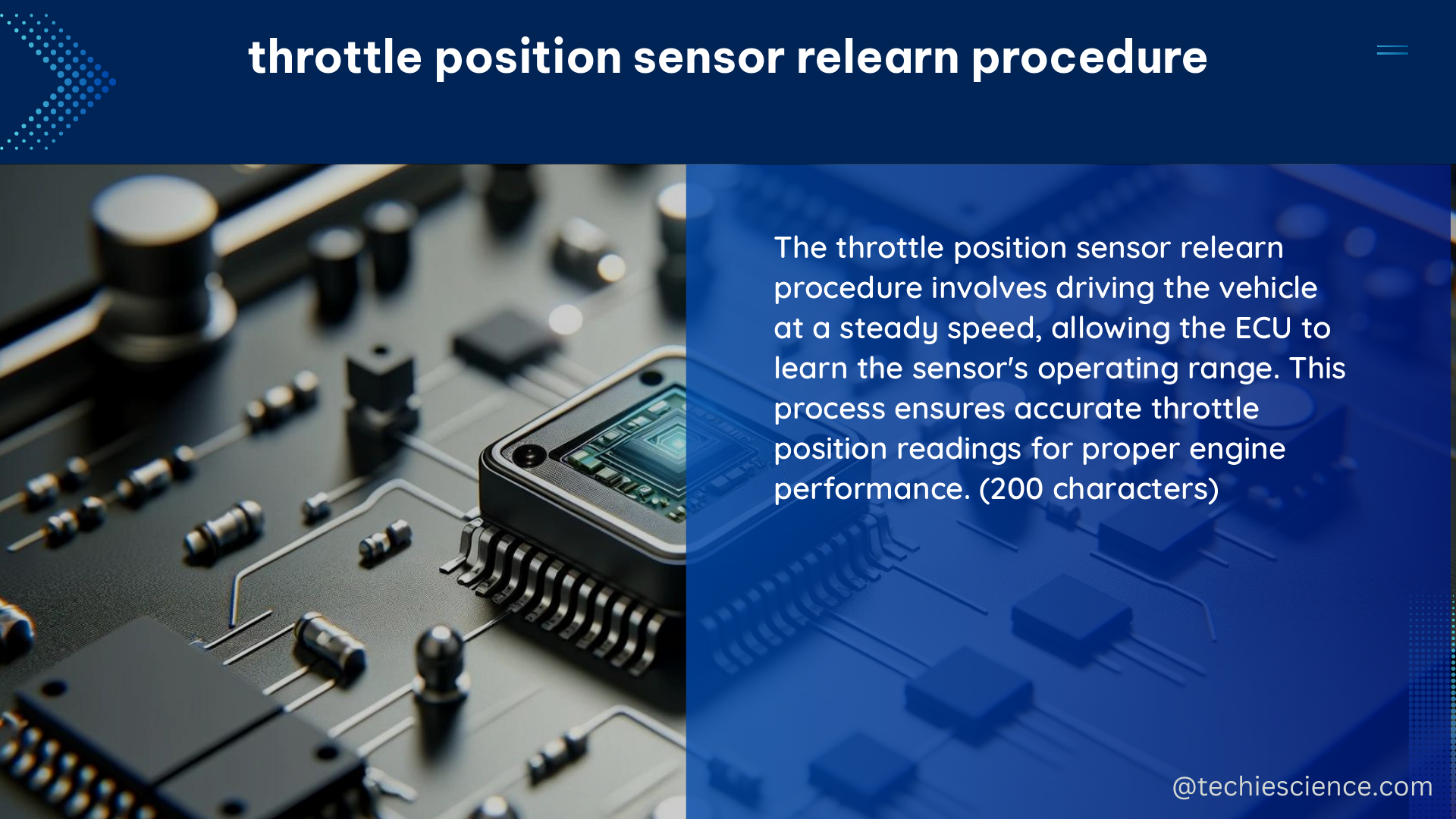The throttle position sensor (TPS) is a critical component in a vehicle’s engine management system, responsible for providing the engine control module (ECM) with information about the position of the throttle. Over time, the TPS may require relearning due to various reasons, such as replacement, cleaning, or battery disconnection. This comprehensive guide will walk you through the throttle position sensor relearn procedure, covering advanced technical specifications, hands-on details, and a step-by-step DIY approach.
Technical Specifications
-
Idle Learning Time: The idle learning time for a TPS can vary between 3 to 15 minutes, depending on the vehicle make and model. This time is essential for the ECM or powertrain control module (PCM) to learn the new idle cells and adjust the throttle blade angle accordingly.
-
Voltage Requirement: To reset the TPS sensor to 0.0% throttle, it is necessary to ensure the TPS sensor output is between 0.5V and 0.6V. This can be achieved using a potentiometer inside the TPS or through a scanner tool.
-
Trouble Codes: Clearing any existing trouble codes before performing the TPS relearn procedure is crucial. Failing to do so may result in incorrect idle speed or the generation of new diagnostic trouble codes.
-
Throttle Body Clean Reset Button: Some scanner tools, like HP Tuners, offer a Throttle Body Clean reset button. This feature resets all idle data to zero, forcing the computer to learn faster and reducing the time required for the idle learn procedure.
-
Throttle Blade Angle: The ECM or PCM will learn the new throttle blade angle during the relearn procedure, ensuring the engine’s idle speed is maintained within the desired range.
-
Sensor Voltage Output: The TPS sensor should output a voltage signal between 0.5V and 4.5V, corresponding to the throttle position from closed to wide open. Any deviation from this range may indicate a problem with the sensor.
-
Sensor Resistance: The resistance of the TPS sensor should typically be between 1 kΩ and 6 kΩ, depending on the specific vehicle model. A resistance outside this range may suggest a faulty sensor.
Throttle Position Sensor Relearn Procedure DIY

- Initial Idle:
- Start and idle the engine in park for 3 minutes.
- The initial idle speed may be higher than normal due to the ECM learning the new idle cells.
-
After this period, the RPM should start to decrease.
-
Ignition Off:
- Turn off the ignition for 60 seconds.
-
This step allows the ECM to reset and prepare for the next learning phase.
-
Second Idle:
- Start and idle the engine in park for another 3 minutes.
- After this period, the engine should be idling normally.
-
If not, it may be necessary to drive the vehicle at speeds above 44 miles per hour with several deceleration and extended idles. After the drive cycle, the engine should now be idling correctly.
-
Throttle Body Clean Reset Button (if available):
- If your scanner tool has a Throttle Body Clean reset button, use it before performing the TPS relearn procedure.
-
This step resets all idle data to zero, forcing the computer to learn faster and reducing the time required for the idle learn procedure.
-
Monitor the Idle:
- Use a scan tool to monitor the actual and desired TPS values.
- Ensure the difference between the actual and desired values is not more than three degrees.
-
If the difference is more than three degrees, it may indicate a fault code or a problem with the TPS.
-
Verify Proper Operation:
- After the relearn procedure, test the throttle response by gently pressing the accelerator pedal.
- The engine should respond smoothly and without any hesitation or jerking.
- If the engine still exhibits issues, further diagnosis may be required.
Remember, the specific steps and technical details may vary depending on the make, model, and year of your vehicle. Always refer to the manufacturer’s recommended procedures and consult your vehicle’s service manual for the most accurate and up-to-date information.
References
- GM Truck Electronic Throttle Body (ETB) Relearn Procedure – https://www.youtube.com/watch?v=NAnEoMa80VY
- TPS wont relearn – EFILive Forum – https://forum.efilive.com/showthread.php
- Throttle Body Relearn Procedure Must do when cleaning or porting throttle body – https://www.tbssowners.com/threads/throttle-body-relearn-procedure-must-do-when-cleaning-or-porting-throttle-body.98477/
- Anybody have the relearn procedure – Lexus Forum Discussion – https://www.clublexus.com/forums/sc430-2nd-gen-2001-2010/805272-anybody-have-the-relearn-procedure.html
- Ford Vehicles: Electronic Throttle Body Calibration Procedure – https://www.youtube.com/watch?v=ZNxXM75zJOw

The lambdageeks.com Core SME Team is a group of experienced subject matter experts from diverse scientific and technical fields including Physics, Chemistry, Technology,Electronics & Electrical Engineering, Automotive, Mechanical Engineering. Our team collaborates to create high-quality, well-researched articles on a wide range of science and technology topics for the lambdageeks.com website.
All Our Senior SME are having more than 7 Years of experience in the respective fields . They are either Working Industry Professionals or assocaited With different Universities. Refer Our Authors Page to get to know About our Core SMEs.